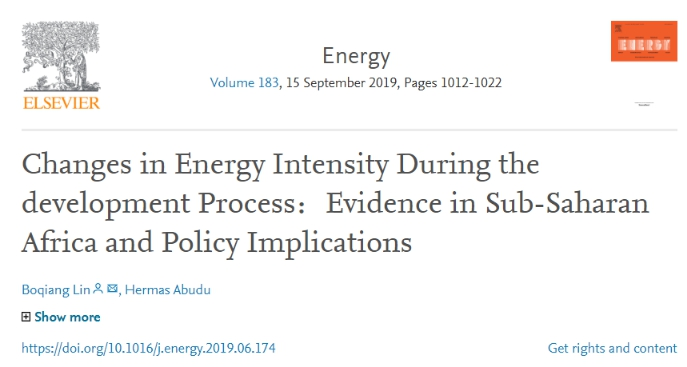
题目:发展过程中能源强度的变化:来自撒哈拉以南非洲的实证和政策建议(Changes in Energy Intensity During the development Process:Evidence in Sub-Saharan Africa and Policy Implications)
作者:林伯强*,Hermas Abudu
期刊:能源(Energy)
详细:183卷,2019年9月15日,1012-1022页
DOI:https://doi.org/10.1016/j.energy.2019.06.174
文献导读:
撒哈拉以南的非洲地区正处于向工业化发展的阶段,目前这些区域的能源系统面临着能源关税、能源平困、能源效率以及相关的气候变化问题。当地政府试图平衡能源消费、经济增长和环境保护三者的关系,但尚未成功。
能源强度通常受能源和其他投入因素之间的替代、技术变化、能源结构变化和经济增长变化的影响。这些因素同时也影响着能源效率、能源安全以及温室气体排放。之前的研究只集中在研究能源消耗、经济增长和环境之间的因果关系,而忽略了估计这个非常关键的重要平衡问题。
撒哈拉以南的非洲地区属于能源消费水平最低的群体,但却拥有着巨大的能源资源。撒哈拉以南的非洲地区应该如何制定战略来降低其能源强度峰值以应对能源贫困的挑战?如何改善能源结构以促进经济增长?本文采用超越对数生产函数,估计了要素产出强度、要素弹性替代性,并评估了它们对经济增长的贡献。
Abstract:
Particularly for developing regions like Sub Saharan Africa, energy intensity is a critical policy issue and usually affected by four challenges: substitution between energy and other factors, technological change, changes in energy composition, and changes of economic growth. This paper examines energy intensity, output elasticity, energy-capital-labor substitution possibility, and factors contribution rates. The study applies a Translog production approach with data spanning 1990–2014 and further, applies ridge regression technique as a robust rectification to achieve unbiasedness in the findings. There is expected evidence of inverse relationship: higher energy intensity in lower per capita economy, evidenced by upward energy tariffs with lower energy elasticity. Factors are inelastic and have average elasticity substitution possibility for capital-energy with their inferential rebound effects’ challenges. However, other combinations indicate complementarity at the current development stage. We further, observe that if higher energy intensity not managed, would translate into higher CO2 intensity, because 99% of total energy is sourced from hydrocarbons of 51% and 48% of biomass. Based on the findings, policymakers and implementors are encouraged to integrate and optimize the whole energy system towards improving energy efficiency through increasing renewable energy composition from the current 1% to at least 10% whiles increasing quality-energy from nonrenewable.
Keywords: Energy intensity; Output elasticity; Energy-capital-labor substitution; Translog-ridge regression technique
 厦大总机:0592-2180000
|
地址:福建省厦门市思明区思明南路422号
|
邮政编码:361005
厦大总机:0592-2180000
|
地址:福建省厦门市思明区思明南路422号
|
邮政编码:361005